Boiled pork belly can vary in appearance depending on how it’s prepared and served. Typically, the pork belly will be simmered in water or broth until it’s cooked through and tender. The skin on the pork belly will often be left on during cooking.
The pork belly may be served whole or sliced, and it’s often accompanied by a dipping sauce or served in a soup or stew. When sliced, boiled pork belly usually has a tender texture with a layer of fat and meat that can be enjoyed on its own or used in other dishes.
But in this article, we will be focusing on a Vietnamese boiled pork belly recipe, which is a popular dish in Vietnam and loved by many. It’s a simple recipe that can be made with just a few ingredients, but it’s sure to impress your taste buds.
Where does pork belly come from?
Pork belly is a cut of meat that comes from the belly of a pig. It’s a fatty and flavorful cut that can be prepared in many different ways, including roasting, grilling, and braising or you can see it used in East Asian and Southeast Asian cuisines, particularly in dishes like ramen, Korean samgyeopsal, and Chinese braised pork belly.
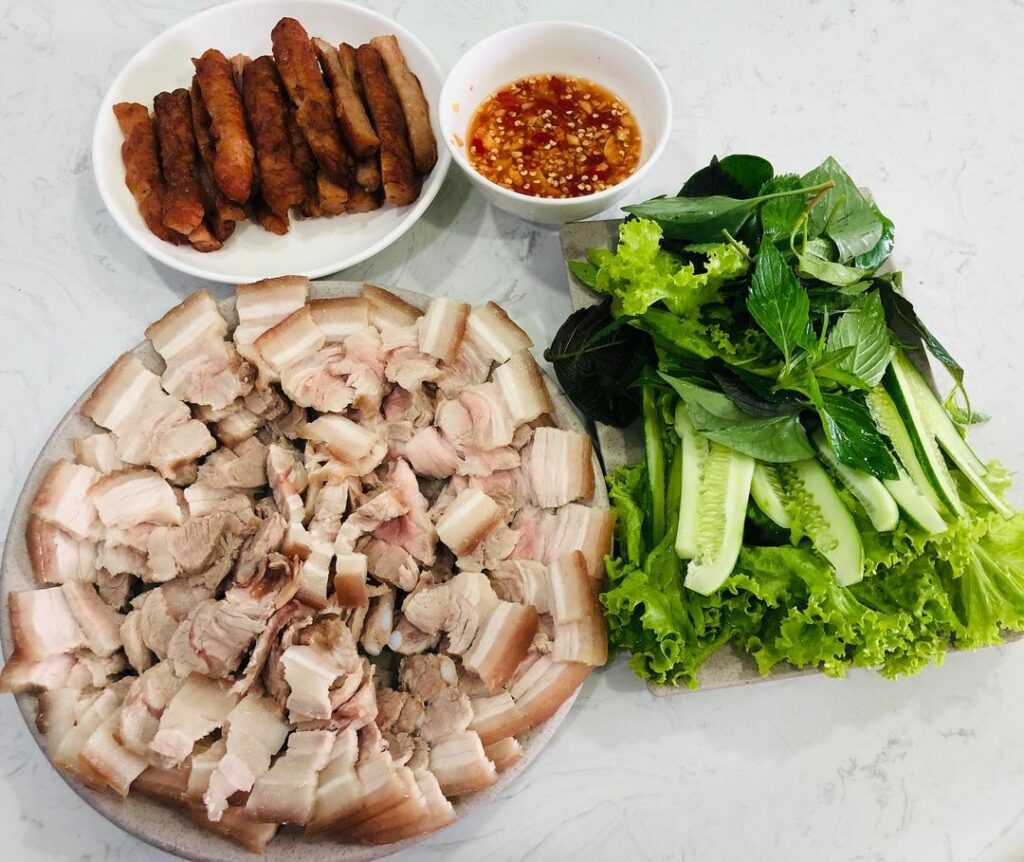
How to boil pork belly in Vietnamese style?
Cooking notes
Here is the boiled pork belly recipe in Vietnamese style, along with some cooking notes:
- Yield: 4 servings
- Prep Time: 10 minutes
- Cook Time: 1 hour
- Total Time: 1 hour and 10 minutes
- Course: Main Course
- Cuisine: Vietnamese
- Equipment: Large pot, strainer, tongs
Ingredients
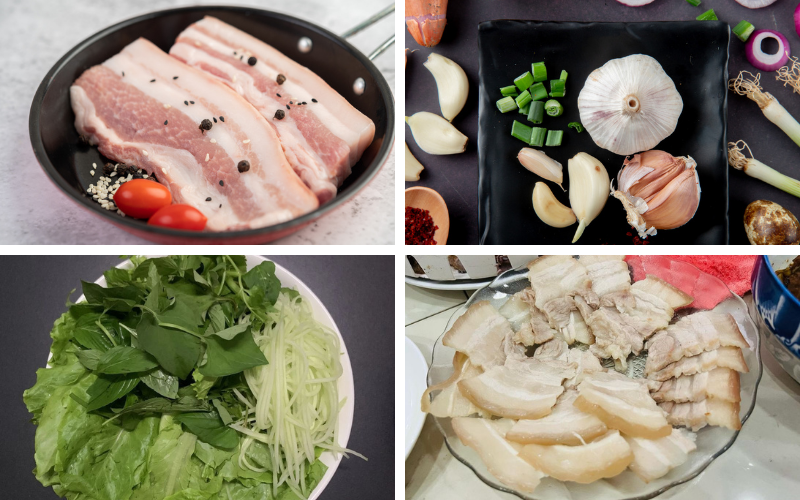
- 1 pound of pork belly
- 6 cups of water
- 1 onion, peeled and halved
- 2 cloves of garlic, smashed
- 3 slices of ginger
- 2 stalks of lemongrass, cut into 2-inch pieces
- 1 tablespoon of fish sauce
- 1 teaspoon of sugar
- Salt and pepper to taste
Instructions
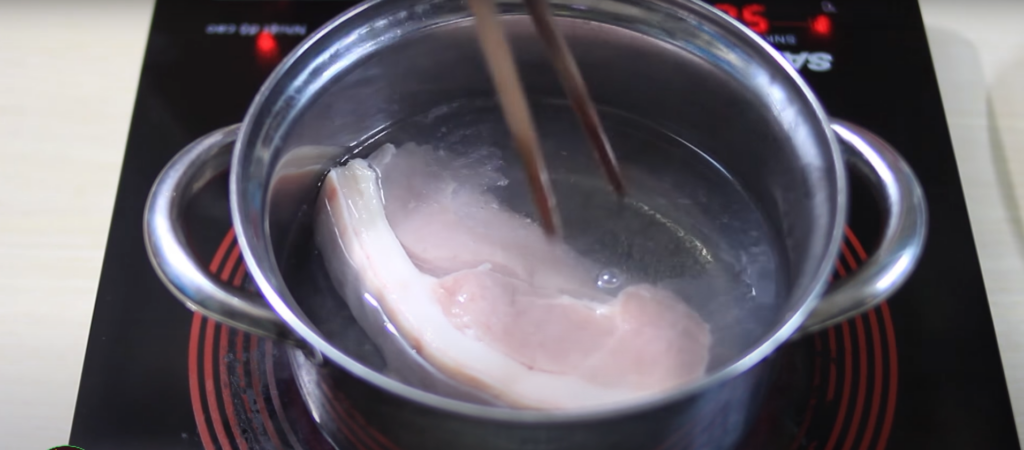
Preparing pork belly for boiling
- Rinse the pork belly under cold water and pat dry with a paper towel.
- Cut the pork belly into 2-inch cubes.
Boiling pork belly
- In a large pot, bring 6 cups of water to a boil.
- Add the pork belly cubes to the pot and bring the water back to a boil.
- Skim off any foam that rises to the top.
- Add the onion, garlic, ginger, lemongrass, fish sauce, and sugar to the pot.
- Reduce the heat to low, cover the pot, and simmer for about 1 hour, or until the pork belly is tender and fully cooked.
- Season with salt and pepper to taste.
Tips for perfectly boiled pork belly
- Use a large pot to ensure the pork belly is fully submerged in the water.
- Skim off any foam that rises to the top to keep the broth clear and free of impurities.
- Adding aromatics like ginger, lemongrass, and onion enhances the flavor of the broth and the pork belly.
- Simmer the pork belly over low heat to ensure it’s tender and fully cooked.
More detail in this video:
How long to boil pork belly?
Based on the instructions provided in the Vietnamese boiled pork belly recipe, the pork belly should be boiled over high heat and then simmered for about 1 hour until it’s tender and fully cooked.
Skim off any foam that rises to the top to keep the broth clear and free of impurities. It’s important to simmer the pork belly over low heat to ensure it’s cooked evenly and doesn’t become tough.
When is pork belly done?
When boiling pork belly, it’s important to know when it’s done cooking to ensure it’s safe to eat and has the right texture.
One way to check if pork belly is done is to use a chopstick to poke the meat while it’s cooking. If the chopstick can go through the pork belly easily without resistance, then the pork belly is fully cooked and ready to eat.
This is a quick and easy way to test the tenderness of the meat without having to cut into it. So, be sure to use this tip on “how to know when boiled pork is done” the next time you’re making boiled pork belly!
What to serve with boiled pork belly?
When serving boiled pork belly, there are several options for complementary dishes. Here are a few suggestions:
Microwave brown rice
If you prefer rice as a side dish, you can opt for microwaveable brown rice. It’s convenient and quick to prepare, providing a nutritious accompaniment to the pork belly. Simply follow the instructions on the packaging to cook the rice.
Types of Vietnam vegetables
Vietnam offers a variety of vegetables that can be served alongside boiled pork belly. Some popular options include:
- Bok Choy: This leafy green vegetable is often used in Vietnamese cooking and can be steamed, stir-fried, or added to soups.
- Water Spinach (Rau Muống): Commonly used in stir-fries, this leafy vegetable has a slightly bitter taste and pairs well with pork belly.
- Morning Glory (Rau Muống): Another popular vegetable in Vietnamese cuisine, morning glory can be stir-fried or blanched and served as a side dish.
- Vietnamese Herbs: Herbs like mint, Thai basil, and cilantro are commonly used in Vietnamese cuisine and can add freshness and flavor to the meal.
Canh Chua (Vietnamese Sweet and Sour Soup)
This tangy and flavorful soup pairs well with boiled pork belly. It typically includes ingredients like tamarind, fish sauce, pineapple, tomatoes, and various vegetables like okra, bean sprouts, and elephant ear stalks. The combination of the soup’s sourness and the rich taste of the pork belly creates a delicious contrast.
Vietnamese spring rolls
Another great option to serve with boiled pork belly is Vietnamese spring rolls (Gỏi cuốn). These refreshing and healthy rolls typically contain vermicelli noodles, fresh vegetables like lettuce, cucumber, and herbs, along with cooked shrimp or sliced pork belly. You can dip them in a savory peanut sauce or nuoc cham, a traditional Vietnamese dipping sauce.
How many calories in cooked pork belly?
Here’s a table of the approximate nutrition facts for Vietnamese boiled pork belly, based on a serving size of 4 ounces (113 grams):
| Nutrient | Amount per Serving |
| Calories | 330 |
| Total Fat | 29 g |
| Saturated Fat | 10 g |
| Cholesterol | 70 mg |
| Sodium | 480 mg |
| Total Carbohydrates | 1 g |
| Protein | 17 g |
It’s important to note that the nutritional value may vary depending on the specific recipe and cooking method used. Additionally, this is a high-calorie and high-fat dish, so it should be consumed in moderation as part of a balanced diet.
How to slice boiled pork belly to serve?
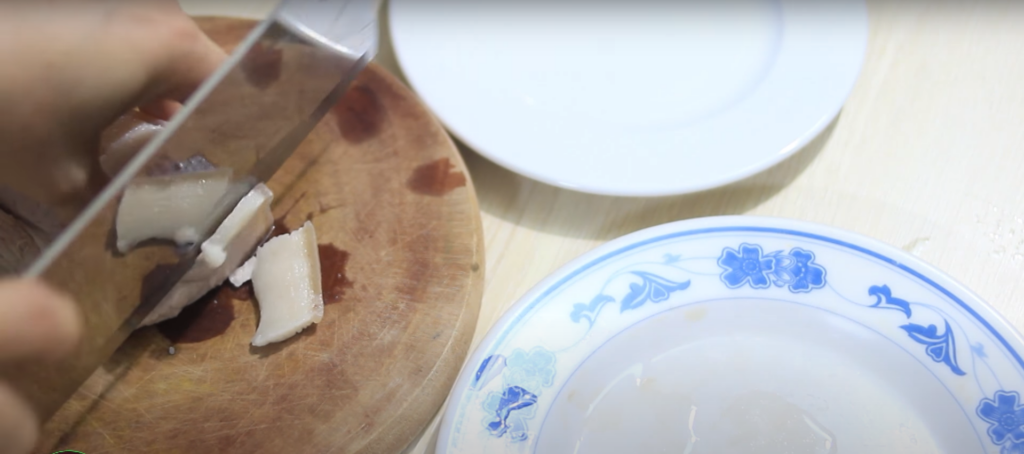
To slice boiled pork belly, first let it cool to room temperature or chill it in the refrigerator. This will help the meat retain its shape and prevent it from falling apart when sliced. Use a sharp knife to cut the pork belly into thin, even slices against the grain.
The thickness of the slices can vary depending on your preference, but thinner slices are generally easier to eat and more flavorful.
How to make sauce to eat with boiled pork belly?
Fish sauce (nước mắm)
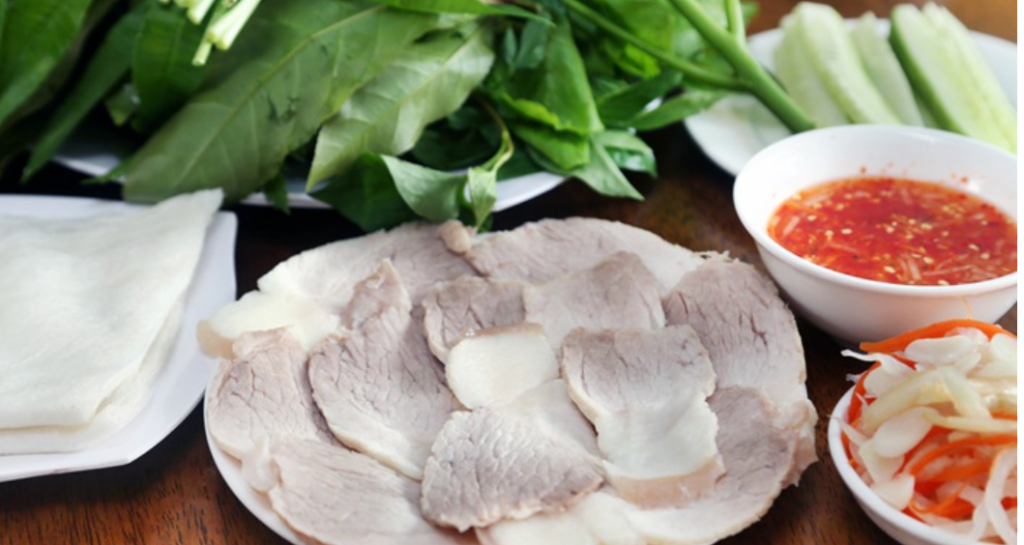
A classic dipping sauce made from fish sauce, water, sugar, lime juice, and chili peppers. It’s a sweet, savory, and tangy sauce that pairs well with the richness of the pork belly.
Vietnamese shrimp paste sauce (mắm tôm)
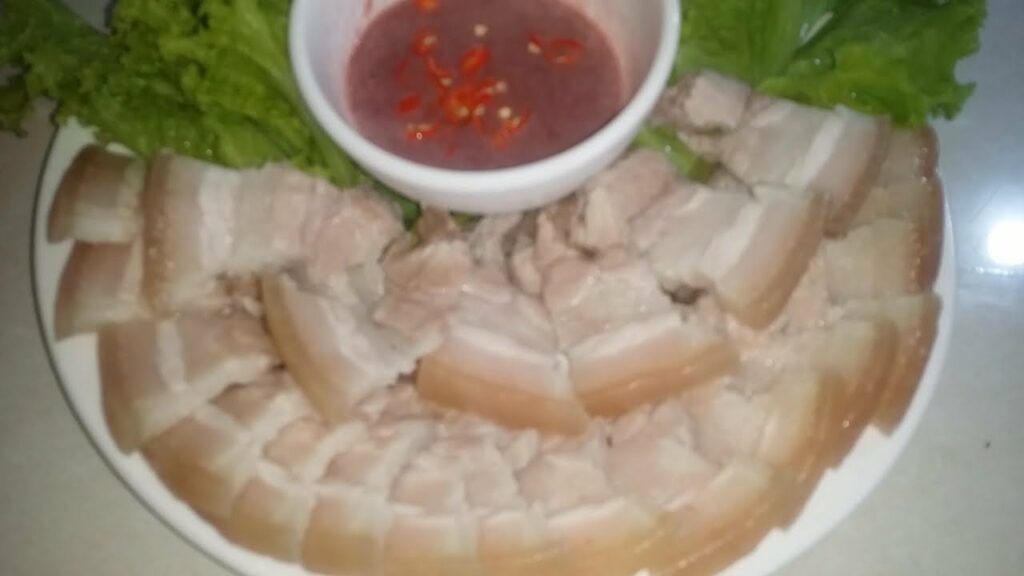
It’s made by fermenting crushed shrimps with salt, which gives it a thick, purple-colored texture and a pungent, stinky smell.
Despite its strong odor, shrimp paste sauce adds a depth of flavor to dishes and complements the rich and savory flavors of boiled pork belly.
You need to mix fermented shrimp paste with water, sugar, lime juice, garlic, and chili peppers before serving.
Fermented shrimp paste sauce (mắm tép)
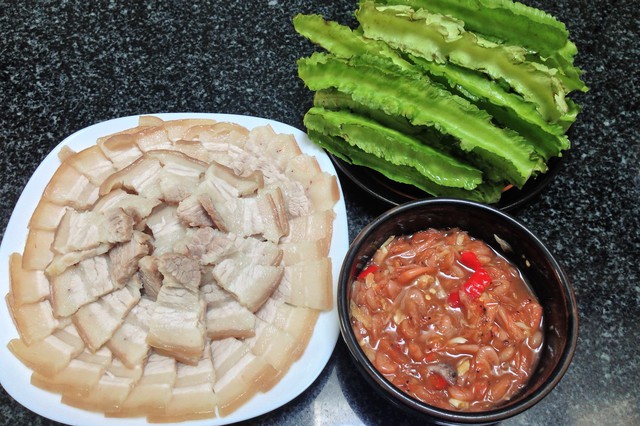
It is made by fermenting small shrimps with salt, resulting in a thick and pungent paste with a strong umami flavor.
Because the paste is naturally salty, it is often diluted with a mixture of sugar, lime juice, and water to create a dipping sauce.
To prepare the dipping sauce, chopped garlic and shallots are sautéed in oil until fragrant, then the diluted shrimp paste mixture is added and simmered for a few minutes.
Fermented tofu sauce (chao)
The sauce is made by mashing fermented tofu with garlic, chili peppers, and sometimes other seasonings like vinegar or sugar. The resulting sauce has a cheesy and tangy flavor that’s quite salty, sometimes spicy, and has a soft, almost paste-like texture.
Fermented anchovy dipping sauce (mắm nêm)
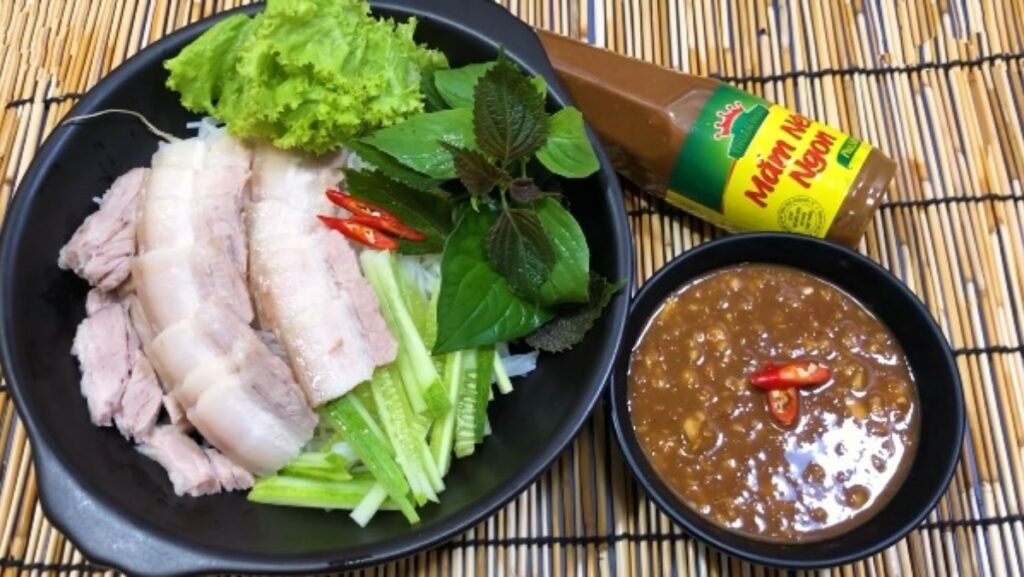
To make fermented anchovy dipping sauce, also known as mắm nêm in Vietnamese cuisine, anchovies are fermented with salt to create a pungent and salty paste.
The paste is then mixed with crushed pineapples, sugar, lemon juice, Thai chili peppers, lemongrass, and garlic, resulting in a complex flavor profile. The sauce is sweet, sour, and spicy, with a strong umami flavor derived from the fermented anchovies.
When paired with boiled pork belly, the bold flavors of mắm nêm provide a delicious contrast to the rich and fatty meat.
How to store boiled pork belly?
If you have leftover boiled pork belly, it’s important to store it properly to prevent spoilage and ensure its freshness. Here are some tips on how to store boiled pork belly:
- Refrigeration: Allow the boiled pork belly to cool to room temperature before storing it in an airtight container or plastic wrap in the refrigerator. It can be stored in the refrigerator for up to 3-4 days.
- Freezing: If you want to store boiled pork belly for a longer period of time, you can freeze it. Allow the pork belly to cool to room temperature, then wrap it tightly in plastic wrap or aluminum foil and place it in a freezer-safe bag or container. It can be stored in the freezer for up to 2-3 months.
How to reheat boiled pork belly?
To reheat boiled pork belly, simply place it in a pot of boiling water for a few minutes until it’s heated through. Alternatively, you can heat it in the microwave or oven, but be careful not to overcook it as this may cause the meat to become tough.
FAQs
Is boiled pork belly healthy?
Boiled pork belly is high in fat and calories, so it should be consumed in moderation as part of a balanced diet. While it does contain some protein, vitamins, and minerals, it’s important to watch your portion sizes and choose leaner protein sources for most of your meals.
What temp cooked pork belly?
Pork belly should be cooked to an internal temperature of 145°F (63°C) to ensure that it’s safe to eat. Use a meat thermometer to check the temperature in the thickest part of the meat.
How long to boil pork belly for spring rolls?
To prepare pork belly for spring rolls, boil it for 30-45 minutes or until it’s fully cooked and tender. Once cooked, let it cool before slicing it thinly and using it as a filling for your spring rolls.
Does boiling pork belly make it tender?
Boiling pork belly can make it tender if it’s cooked properly and for the right amount of time.
Why is my pork hard after boiling it?
If pork is hard after boiling, it may be overcooked or cooked at too high of a temperature.
Does pork get more tender the longer you boil it?
Pork can become more tender the longer it’s boiled, but only up to a certain point. Overcooking can result in tough meat.
Does pork belly have to be boiled first?
Pork belly doesn’t necessarily have to be boiled first, but it’s a common preparation method for many dishes that use this cut of meat.
Conclusion
With this guide, you should have a better understanding of what boiled pork belly is, how to prepare and cook it, its nutritional value and health benefits, and other ways to cook it. Whether you are a seasoned cook or a beginner, this guide will give you the confidence to try this delicious meat.
More pork recipes
- Roasted Pork Belly Banh Mi Recipe
- Vietnamese Caramelized Pork Belly (Easy Thit Kho Recipe)
- Xiu Mai (Vietnamese Meatballs)